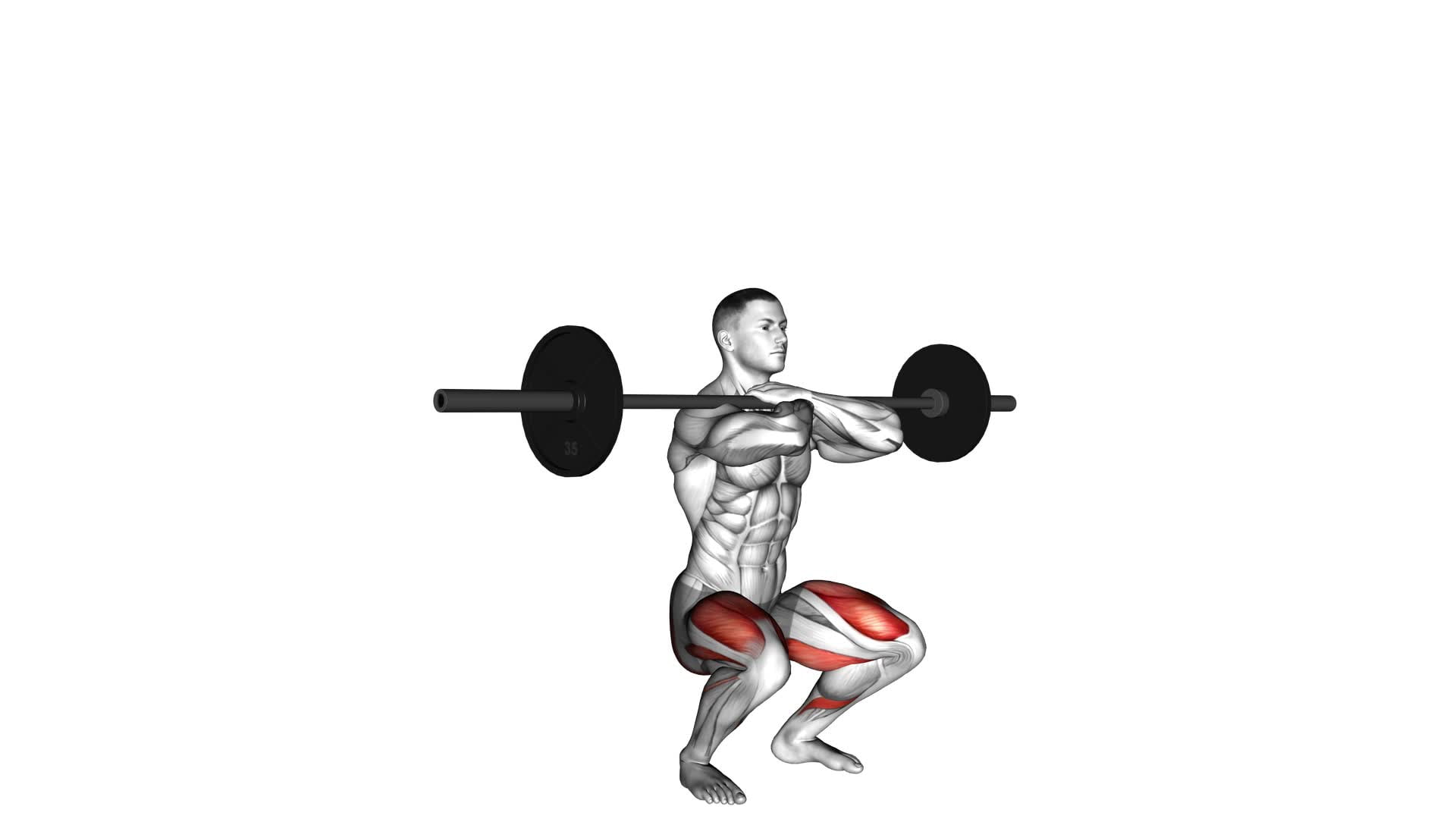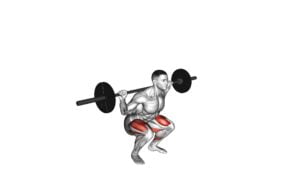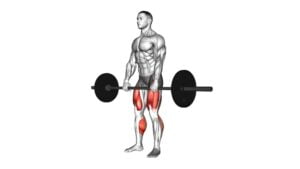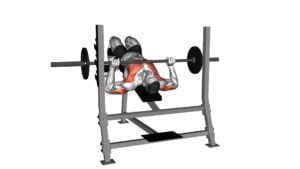Barbell Pause Front Squat – Video Exercise Guide & Tips

Looking to improve your front squat technique? Check out this video exercise guide and tips for the barbell pause front squat.
Watch This Exercise Video
This variation of the front squat helps build strength and stability in your lower body.
Learn the proper equipment and set-up, step-by-step instructions, common mistakes to avoid, and tips for increasing intensity and progression.
Plus, we'll cover safety precautions and modifications to ensure you get the most out of this exercise.
Let's dive in and perfect your front squat form!
Key Takeaways
- Barbell Pause Front Squat targets lower body muscles like quadriceps, hamstrings, and glutes.
- It increases lower body strength by engaging muscles for a longer period.
- The exercise enhances stability and balance.
- Barbell Pause Front Squat improves technique and corrects imbalances in squatting.
Benefits of the Barbell Pause Front Squat
You can experience numerous benefits by incorporating the Barbell Pause Front Squat into your workout routine. This exercise not only targets your lower body muscles like the quadriceps, hamstrings, and glutes, but it also offers several advantages for your overall fitness and technique improvements.
One of the main benefits of the Barbell Pause Front Squat is its ability to increase lower body strength. By holding the barbell in front of your body and pausing at the bottom of the squat, you engage your muscles for a longer period, leading to greater strength gains over time.
In addition to strength, this exercise also enhances your stability and balance. As you lower down into the squat and hold the pause, you're challenged to maintain proper form and control. This helps to improve your balance and stability, which can translate into better performance in other exercises and daily activities.
Furthermore, the Barbell Pause Front Squat can also improve your technique. The pause at the bottom of the squat allows you to focus on your form, ensuring that you're maintaining proper alignment and depth. This can help to correct any imbalances or weaknesses in your squatting technique, leading to better overall movement patterns.
Proper Equipment and Set-Up
To properly perform the barbell pause front squat, there are a few essential pieces of equipment you'll need. First, you'll need a barbell with weights that you can comfortably lift.
Additionally, you'll want to ensure your barbell is positioned correctly, resting on the front of your shoulders and collarbone. This optimal positioning will help you maintain balance and stability throughout the exercise.
Essential Equipment for Setup
To properly set up for the Barbell Pause Front Squat, it's important to have the essential equipment in place. When it comes to equipment options, you'll need a barbell, weight plates, and a squat rack or a power rack.
The barbell should be loaded with an appropriate weight that challenges you but allows you to maintain proper form. The squat rack or power rack will provide a safe and stable environment for performing the exercise.
In terms of setup variations, you can choose to use a clean grip or a cross grip for holding the barbell. Both grips have their advantages, so it's up to you to decide which one feels more comfortable and allows you to maintain good technique throughout the exercise.
Remember to always prioritize safety and proper form when selecting your equipment and setup.
Optimal Barbell Positioning
Once you have properly set up the essential equipment for the Barbell Pause Front Squat, the next step is to position the barbell optimally for maximum effectiveness. To ensure proper form and muscle activation, follow these guidelines:
- Place the barbell across the front of your shoulders, just below your collarbone. This position allows for better stability and control during the exercise.
- Grip the barbell with your hands slightly wider than shoulder-width apart. This grip width helps maintain balance and control throughout the movement.
- Keep your elbows high and pointed forward. This position helps engage your upper back muscles and keeps your chest lifted, promoting proper posture.
Step-by-Step Guide to Performing the Barbell Pause Front Squat
Now let's talk about the best pause duration and common mistakes to avoid when performing the barbell pause front squat.
It's important to find the right pause duration that challenges your muscles without compromising form. Avoid rushing through the pause or holding it for too long, as both can affect your technique and results.
Additionally, be mindful of common mistakes such as rounding your back or letting your knees cave in, and focus on maintaining proper form throughout the exercise.
Best Pause Duration
Choose a pause duration of 2-3 seconds for optimal performance of the barbell pause front squat. This pause allows for maximum muscle activation and helps develop strength and stability in the squatting movement. Here's why a 2-3 second pause is the best choice:
- Enhanced muscle activation: The longer pause duration allows for greater recruitment of muscle fibers, leading to increased muscle activation and growth.
- Improved technique: Pausing at the bottom of the squat helps you maintain proper form and balance, enabling you to execute the exercise with optimal technique.
- Increased strength development: The pause forces you to overcome the inertia of the weight, making the subsequent upward movement more challenging and effective for building strength.
Common Mistakes to Avoid
To perform the barbell pause front squat correctly, focus on maintaining proper form and avoiding common mistakes.
One common mistake is allowing your knees to cave inwards during the squat. To prevent this, make sure to push your knees outwards as you lower yourself down.
Another mistake to avoid is rounding your back during the movement. Keep your back straight and your chest up throughout the exercise.
Additionally, be careful not to rush the movement and sacrifice proper technique. Take your time and pause at the bottom of the squat to ensure stability and control.
Lastly, make sure to use an appropriate weight for your fitness level to avoid injury and maximize the benefits of the exercise.
Common Mistakes to Avoid
To avoid common mistakes, focus on maintaining proper form and technique while performing the barbell pause front squat. Here are three common mistakes to watch out for:
- Poor squat depth: One of the most common mistakes isn't going low enough during the squat. Make sure to squat down until your thighs are parallel to the ground, keeping your knees in line with your toes. This ensures that you're engaging the proper muscles and maximizing the benefits of the exercise.
- Leaning too far forward: Another mistake is leaning too far forward, which puts excessive strain on your lower back and can lead to injury. Keep your chest up, back straight, and weight evenly distributed on your feet. This will help you maintain balance and stability throughout the movement.
- Allowing your knees to collapse inward: It's important to keep your knees in line with your toes throughout the exercise. Allowing your knees to cave in can put unnecessary stress on the knee joints and increase the risk of injury. Focus on pushing your knees out and maintaining proper alignment.
By avoiding these common mistakes and focusing on proper form, you can perform the barbell pause front squat safely and effectively.
Now, let's move on to the next section where we'll discuss tips for increasing intensity and progression.
Tips for Increasing Intensity and Progression
To increase the intensity and progression of your barbell pause front squats, incorporate these three tips into your training routine.
First, gradually increase the weight you're lifting. As you become more comfortable with the exercise and your form improves, add small increments of weight to challenge your muscles and stimulate growth. This gradual progression will help you build strength and endurance over time.
Second, vary your sets and reps. Instead of sticking to the same number of sets and reps every time, try incorporating different rep ranges and set variations. For example, you could perform 3 sets of 8 reps one day, and then switch to 4 sets of 6 reps the next. This variation won't only keep your workouts interesting but also challenge your muscles in different ways, leading to increased intensity and progression.
Lastly, incorporate tempo variations. Instead of performing the barbell pause front squat at a regular pace, try slowing down the lowering phase, pausing at the bottom, and then exploding back up. This controlled tempo will engage your muscles more effectively, resulting in increased intensity and progression.
By following these tips, you can effectively increase the intensity and progression of your barbell pause front squats.
Now, let's move on to the next section, where we'll discuss important safety precautions and modifications.
Safety Precautions and Modifications
Now let's focus on the important safety precautions and modifications you should consider when performing the barbell pause front squat. To ensure your safety and make the exercise more effective, follow these guidelines:
- Start with proper warm-up: Before attempting the barbell pause front squat, warm up your muscles and joints with dynamic stretches and mobility exercises. This will help prevent injuries and improve your overall performance.
- Master the proper form: It's crucial to maintain proper form throughout the exercise. Keep your back straight, chest up, and heels firmly on the ground. Avoid rounding your back or letting your knees cave in. If you struggle with the correct form, consider working with a qualified trainer to help you.
- Safety modifications and alternative exercises: If you have any existing injuries or limitations, it's important to modify the exercise to accommodate your needs. You can try using a lighter weight or even perform the exercise with dumbbells instead of a barbell. Additionally, there are alternative exercises such as goblet squats or Bulgarian split squats that target similar muscle groups while reducing strain on the joints.
Frequently Asked Questions
How Does the Barbell Pause Front Squat Differ From a Regular Front Squat?
The Barbell Pause Front Squat differs from a regular front squat in that it involves a pause at the bottom of the squat. This pause helps to improve your strength and stability in the bottom position. By holding the pause, you're forcing your muscles to work harder to maintain the position, leading to increased muscle activation and better overall squatting technique.
The benefits of the Barbell Pause Front Squat include improved strength, stability, and technique in the front squat movement.
Can I Perform the Barbell Pause Front Squat With Dumbbells Instead of a Barbell?
Yes, you can perform the barbell pause front squat with dumbbells instead of a barbell. However, using dumbbells may change the dynamics and balance of the exercise.
The barbell pause front squat has specific benefits, such as improving strength, stability, and mobility in the lower body. It also helps develop core strength and enhances your overall squatting technique. Incorporating pauses during the exercise challenges your muscles and promotes better control and stability.
How Long Should the Pause Be During the Barbell Pause Front Squat?
During the barbell pause front squat, the length of the pause is important for maximizing its benefits. The pause should last for about 2-3 seconds at the bottom of the squat.
This allows you to engage your muscles and improve stability and strength. It also helps to improve your technique and range of motion.
Remember to maintain proper form and keep your core engaged throughout the exercise.
Can the Barbell Pause Front Squat Help Improve My Vertical Jump?
The barbell pause front squat is a great exercise to improve your overall lower body strength. By adding a pause at the bottom of the squat, you're challenging your muscles to work harder and develop more power.
This can directly translate to an increase in your vertical jump. Incorporating barbell pause front squats into a comprehensive vertical jump training program can help you achieve better results and reach new heights in your athletic performance.
Is the Barbell Pause Front Squat Suitable for Beginners or Is It More Advanced?
The barbell pause front squat can be suitable for both beginners and advanced lifters. It's a challenging exercise that requires proper form and technique.
Beginners can start with lighter weights and focus on mastering the movement before progressing to heavier loads.
Advanced lifters can benefit from the pause at the bottom of the squat, which increases time under tension and strengthens the quadriceps and glutes.
Remember to consult with a fitness professional to ensure proper execution.
Conclusion
In conclusion, the barbell pause front squat is a beneficial exercise for increasing strength and stability in the lower body.
By following the proper equipment set-up and step-by-step guide, you can perform this exercise effectively.
It's important to avoid common mistakes and focus on increasing intensity and progression over time.
Remember to prioritize safety precautions and make modifications as needed.
Incorporating the barbell pause front squat into your workout routine can help you achieve your fitness goals.

Author
Years ago, the spark of my life’s passion ignited in my mind the moment I stepped into the local gym for the first time. The inaugural bead of perspiration, the initial endeavor, the very first surge of endorphins, and a sense of pride that washed over me post-workout marked the beginning of my deep-seated interest in strength sports, fitness, and sports nutrition. This very curiosity blossomed rapidly into a profound fascination, propelling me to earn a Master’s degree in Physical Education from the Academy of Physical Education in Krakow, followed by a Sports Manager diploma from the Jagiellonian University. My journey of growth led me to gain more specialized qualifications, such as being a certified personal trainer with a focus on sports dietetics, a lifeguard, and an instructor for wellness and corrective gymnastics. Theoretical knowledge paired seamlessly with practical experience, reinforcing my belief that the transformation of individuals under my guidance was also a reflection of my personal growth. This belief holds true even today. Each day, I strive to push the boundaries and explore new realms. These realms gently elevate me to greater heights. The unique combination of passion for my field and the continuous quest for growth fuels my drive to break new ground.



